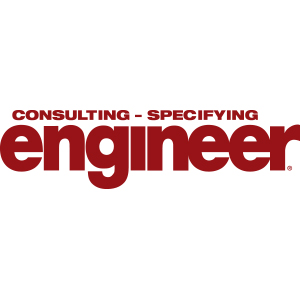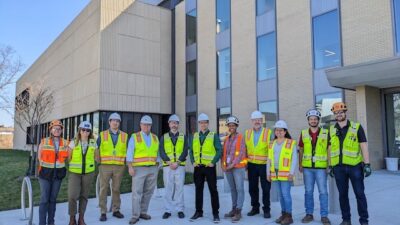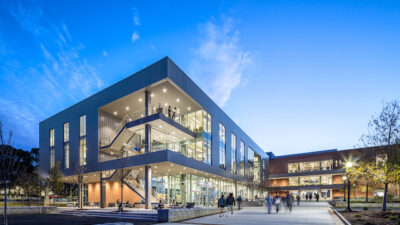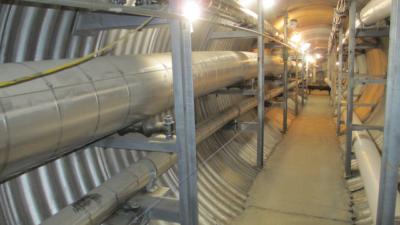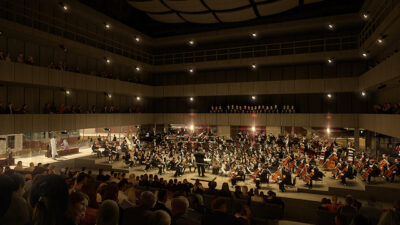Sustainability initiatives like WELL, LEED and net-zero energy are driving system design in university buildings.
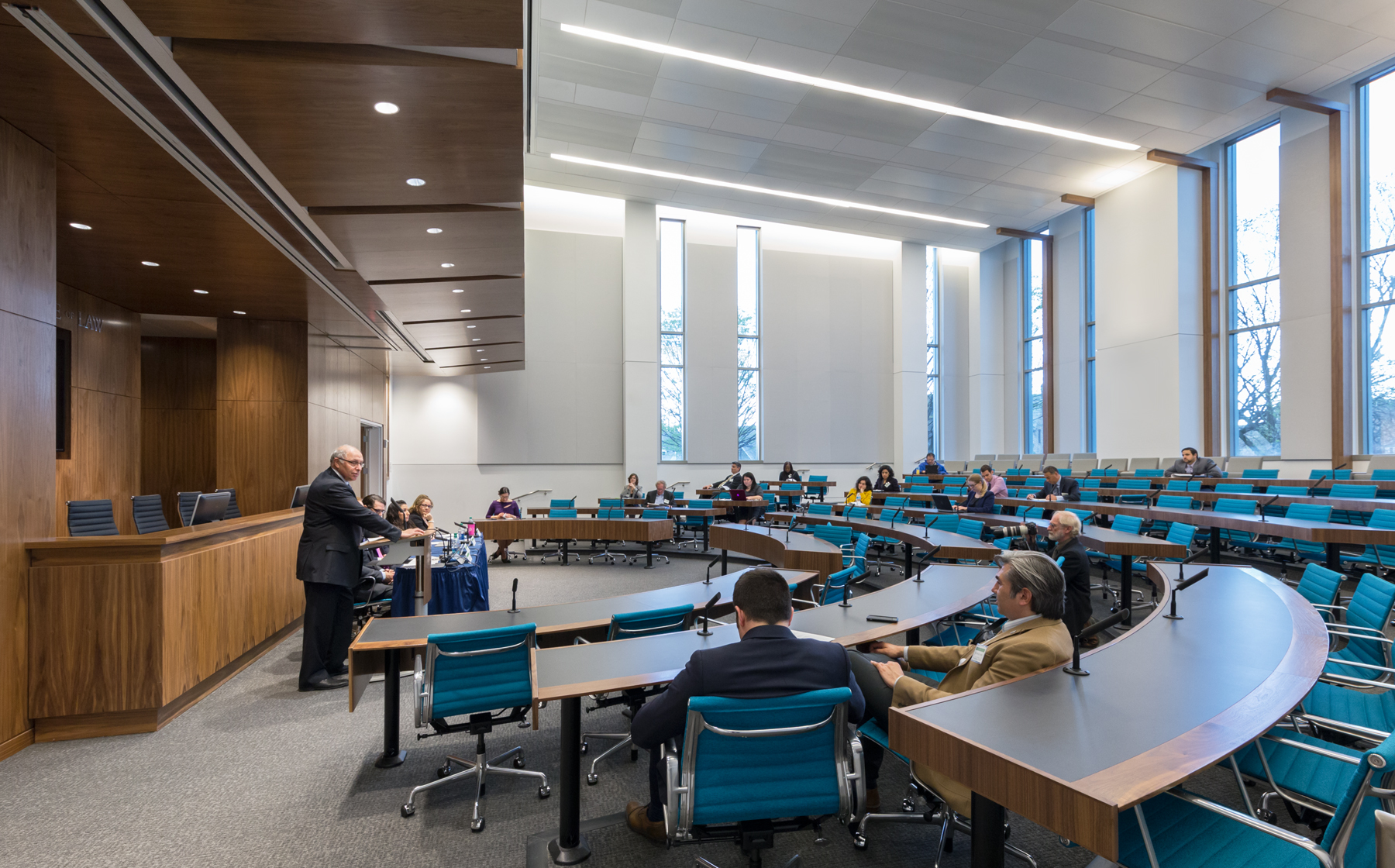
Learning objectives:
- Understand how to go above and beyond code expectations to meet sustainability goals.
- Learn about efficiency considerations for HVAC, lighting and electrical systems on college campuses.
Sustainability insights:
- To boost energy efficiency, colleges and universities are increasingly requesting unconventional systems and features that go beyond standard code compliance.
- Common campus goals include eliminating fossil fuel combustion, reducing total emissions by a fixed percentage by a certain year and offsetting remaining emissions.
Respondents:
Dennis Coblentz, Project Manager, RMF Engineering, Charleston, SC
Cindy Cogil, PE, FASHRAE, Vice President, SmithGroup, Chicago, IL
Abdullah Khaliqi, PE, MCPPO, CPQ, Principal, Academic, Fitzemeyer & Tocci Associates, Inc., Woburn, MA
What level of performance are you being asked to achieve, such as WELL Building Standards, U.S. Green Building Council LEED certification, net zero energy, Passive House or other guidelines? Describe a project and its goals, identifying the geographic location of the building.
Cindy Cogil: Most university building projects aim first for Gold, then for Silver for LEED certification. These two levels of LEED certification comprise 86% of LEED Certified projects in higher education that our firm has completed, with the remaining projects generally split between Certified and Platinum. The majority of LEED Certified higher education projects are located in the East and Midwest regions, followed by the Southwest, then West. We do not currently have any higher education projects that have pursued the WELL Building Standard.
What unusual systems or features are being requested to make college and university projects more energy efficient?
Abdullah Khaliqi: To boost energy efficiency, colleges and universities are increasingly requesting unconventional systems and features that go beyond standard code compliance. These include geothermal well fields, thermal energy storage tanks and building integrated photovoltaics for onsite renewable generation. We’ve also specified radiant heating and cooling systems and active chilled beams for thermal regulation in high performance buildings. Some campuses are adopting district energy systems or microgrids to optimize energy use across multiple buildings. Advanced occupant sensing controls, plug load management and real-time energy dashboards are also being implemented to engage users and fine tune energy consumption.
What types of sustainable features or concerns might you encounter for these buildings that you wouldn’t on other projects?
Abdullah Khaliqi: College and university buildings often prioritize long-term sustainability goals that go beyond typical commercial projects. We frequently encounter requests for net zero energy readiness, low embodied carbon materials and resilient infrastructure to support academic continuity during extreme weather. Campuses often include green roofs, rainwater harvesting or bioswales to meet sustainability and stormwater management targets. There’s also growing interest in interactive sustainability features, like real-time energy dashboards or exposed systems that serve both operational and educational purposes. These projects require balancing high performance with flexibility for future retrofits, student health and mission alignment, making sustainability deeply integrated into every design decision.
What types of renewable energy systems have you recently specified to provide power, such as solar photovoltaics? Describe the challenges and solutions.
Abdullah Khaliqi: We’ve recently specified several solar photovoltaic (PV) systems for university campuses, including rooftop arrays and solar canopies over parking lots. We have also left projects solar ready by prepping for future building integrated PVs. Challenges include structural limitations, roof shading from mechanical equipment and aligning generation with peak load profiles. We addressed these by conducting a detailed solar analysis, coordinating early with structural engineers and integrating a battery energy storage system for peak shaving and resilience. Ongoing collaboration with campus energy teams ensured long term performance and maintainability.
What are some of the challenges or issues when designing for water use in such facilities, particularly campus buildings with high water needs?
Abdullah Khaliqi: Designing for water use in campus buildings with high demand, such as labs, residence halls and athletic facilities presents several challenges. These include peak usage variability, aging infrastructure and meeting efficiency goals without compromising performance. In science buildings, managing process water and ensuring backflow prevention are critical. For residence halls, we address high volume domestic hot water needs with centralized high efficiency water heaters or heat pump water heaters, while ensuring low flow fixtures meet user expectations. Athletic centers often require specialized systems for pool filtration, irrigation and locker room drainage. Solutions include submetering, graywater reuse and leak detection to monitor and reduce consumption.
How has the demand for energy recovery technology influenced the design for these kinds of projects?
Abdullah Khaliqi: The demand for energy recovery technology has significantly influenced HVAC design in college and university projects, especially as institutions aim for LEED certification, net zero goals or compliance with ASHRAE Standard 90.1: Energy Standard for Buildings Except Low-Rise Residential Buildings. We now commonly integrate energy recovery ventilators (ERVs) or enthalpy wheels into dedicated outdoor air systems (DOAS) to reclaim heat and humidity from exhaust air. In labs, we’ve used runaround coil loops or heat pipe systems to recover energy while maintaining air separation. These technologies reduce HVAC loads, lower utility costs and improve indoor air quality (IAQ). Their use requires careful coordination of duct routing, controls integration and freeze protection strategies.
What value-add items are you adding these kinds of facilities to make the buildings perform at a higher and more efficient level?
Abdullah Khaliqi: To enhance building performance and efficiency, we’re incorporating several value-add features into college and university projects. These include smart building analytics platforms that track energy, IAQ and occupancy in real time, helping facility teams optimize operations. We also specify advanced metering systems, building automation systems with integrated fault detection and commissioning friendly controls to streamline maintenance and performance tracking. Other strategies include demand-controlled ventilation, MERV 13+ filtration and automated shading systems to reduce thermal load. In academic buildings, we often add energy dashboards or exposed systems to support student learning. These elements boost long term value by improving sustainability, resilience and user engagement.
How have energy recovery products evolved to better assist in designing these projects?
Abdullah Khaliqi: Energy recovery products have evolved significantly, offering greater flexibility, efficiency and integration to support high performance campus designs. Modern ERVs now feature variable speed fans, electronically commutated motors and intelligent controls that adjust to real-time load conditions, maximizing energy savings. Enthalpy wheels have improved in moisture transfer efficiency and durability, making them more suitable for humid or cold climates. In laboratory settings, runaround loops and heat pipe systems offer energy recovery without cross contamination. Manufacturers also now offer compact, modular units ideal for retrofit projects with tight space constraints. These advancements make it easier to meet ventilation and energy goals simultaneously.
What types of decarbonization goals have you had to meet, and how have you met them?
Cindy Cogil: Campus goals include eliminating fossil fuel combustion, reducing total emissions by a fixed percentage by a certain year and offsetting remaining emissions. One building project prohibited fossil fuel combustion and required 5 percent on-site renewable energy. It comprised a hybrid, multi-source heat pump system and a combination of canopy style photovoltaics, building-integrated photovoltaics and photovoltaic glass sun shades. We are developing campus decarbonization plans that provide a pathway based on programmatic changes, building-level energy conservation measures, renewable energy installations and the conversion of existing district thermal energy plants to low-carbon alternatives and include custom interactive energy and emissions forecasting tools.
Abdullah Khaliqi: Many universities are setting ambitious decarbonization goals, such as achieving net zero carbon by 2040 or eliminating onsite fossil fuel use. To meet these targets, we’ve designed all electric HVAC systems using air source or ground source heat pumps, eliminated gas fired boilers and specified induction cooktops in kitchen spaces. We pair these systems with solar PV, battery energy storage, and smart building controls to optimize energy use and reduce emissions. In multiple campus projects, we have retrofitted steam heated buildings with a low temperature hot water system served by heat pumps, reducing site emissions. Early modeling and stakeholder alignment were key.
